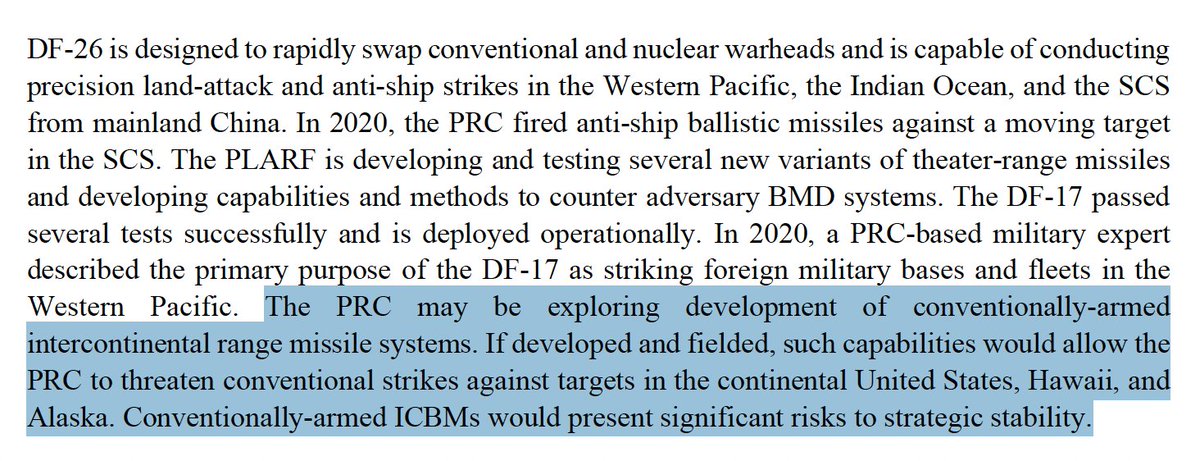Moving on, here's part 2 of this thread on the 2024 China Military Power report.
First up, the PLA Rocket Force, which is where IMO biggest news resides.
First up, the PLA Rocket Force, which is where IMO biggest news resides.
https://x.com/tshugart3/status/1869747458152284414
First, the report provides a section on PLARF force structure, with an estimate ICBM brigades have 6-12 launchers, other brigades 24-48—a detail I don't recall from previous reports.
Also, it details there's probably different C2 for nuclear vs. conventional ops, also new AFAIK.
Also, it details there's probably different C2 for nuclear vs. conventional ops, also new AFAIK.

The report also reveals the DF-21C MRBM is on its way out, with no more dedicated brigades operating it (I assume there are still DF-21D anti-ship brigades?). 

In a discussion of PLARF ICBM survivability, the report adds a new sentence that the PRC is considering rail-mobile DF-41s. This option has been discussed in open source before, but it's interesting to see it added here.
Note: zero discussion of a "shell game" option for ICBMs.
Note: zero discussion of a "shell game" option for ICBMs.

Interestingly, the passage discussing PRC conventional ICBM development deletes a sentence about resulting risks to strategic stability that was in last year's report (shown here).
Maybe a bit too much opining last year?
Maybe a bit too much opining last year?

Jumping to the Rocket Force table at the end of the report, we see what I think is the biggest news: an increase of 300 MRBMs, to 1300 (and also 100 more SRBM launchers). 



This year's chart helpfully lists which missiles DoD includes in each category.
Here's a version of the chart annotated with my best guesses of the more common DF-numbers (sources differ), and the changes from last year. I'm guessing "other" is the DF-27, more on that later.
Here's a version of the chart annotated with my best guesses of the more common DF-numbers (sources differ), and the changes from last year. I'm guessing "other" is the DF-27, more on that later.

Anyway, the increase to 1300 MRBMs is a lot on its own, but IMO it has to be considered on top of the fact this estimate increased to 1000 in 2023, up from 500/600 in the previous years' reports, a more-than-doubling overall.
Here's a chart of the numbers from the last 5 years:
Here's a chart of the numbers from the last 5 years:

Why does this matter? Because PLA doctrine is obsessed with striking suddenly/by surprise, they continue to put enormous resources into exactly the kind of forces (like MRBMs) you'd need to do so, and they appear to have been practicing doing so for years. warontherocks.com/2017/02/has-ch…
In 2017, a colleague and I estimated that the PLARF had the ability to comprehensively strike every US base in Japan—cratering runways, hitting ships in port, and destroying command centers and aircraft on the ground.
Their inventory then? 200-300 MRBMs.
cnas.org/publications/r…
Their inventory then? 200-300 MRBMs.
cnas.org/publications/r…
So what does 1300 MRBMs mean? In revised estimates I recently completed, I now think the PLA likely has the capacity to deliver a single strike, starting with ballistic/hypersonic missiles, that could cover not only every US base in Japan, but also the JSDF's main bases & ports.
I estimate they now have the capacity to strike in a single salvo every BMD unit, crater every runway at combat aircraft bases, sweep all the ramps at those bases with submunitions, hit every ship in port, every hardened aircraft shelter, & destroy US command center, plus more.
Now I get it: a lot of smart folks I respect think that a large-scale attack is unlikely, that it would be bad strategy that would embroil the PRC in a major war (which I agree with).
But again—they talk about doing it, they practice doing it, and they're resourcing for it...
But again—they talk about doing it, they practice doing it, and they're resourcing for it...
Anyway, moving on...the last 2 years' reports mentioned the new DF-27 missile, but with scant details.
This year we get them: an HGV payload and multiple roles—land-attack, anti-ship and nuclear. It's borderline IRBM/ICBM, can probably hit as far as Hawaii (hello, Camp Smith).
This year we get them: an HGV payload and multiple roles—land-attack, anti-ship and nuclear. It's borderline IRBM/ICBM, can probably hit as far as Hawaii (hello, Camp Smith).

While the information cutoff date for this year's report was probably too early for it to include the recent trans-Pacific PRC ICBM launch, it did reveal that in 2023 the PLARF conducted a multi-ICBM DF-31 launch across China. 

Moving on—in the next installment: nuclear forces
Here's a link to part 3:
https://x.com/tshugart3/status/1869774526458061246
• • •
Missing some Tweet in this thread? You can try to
force a refresh














